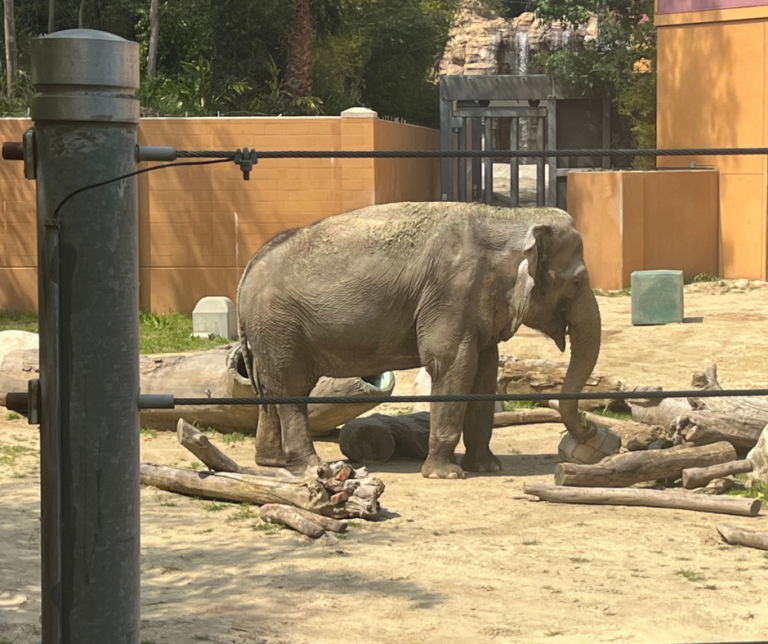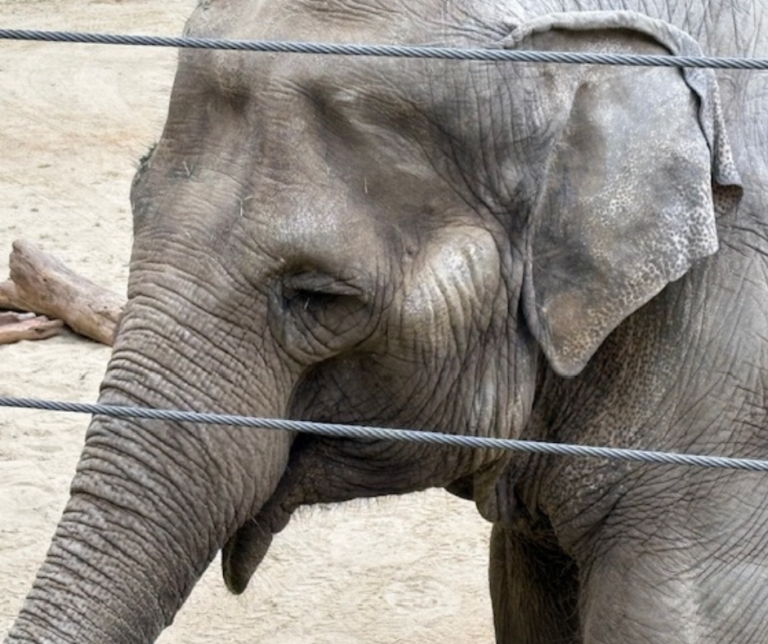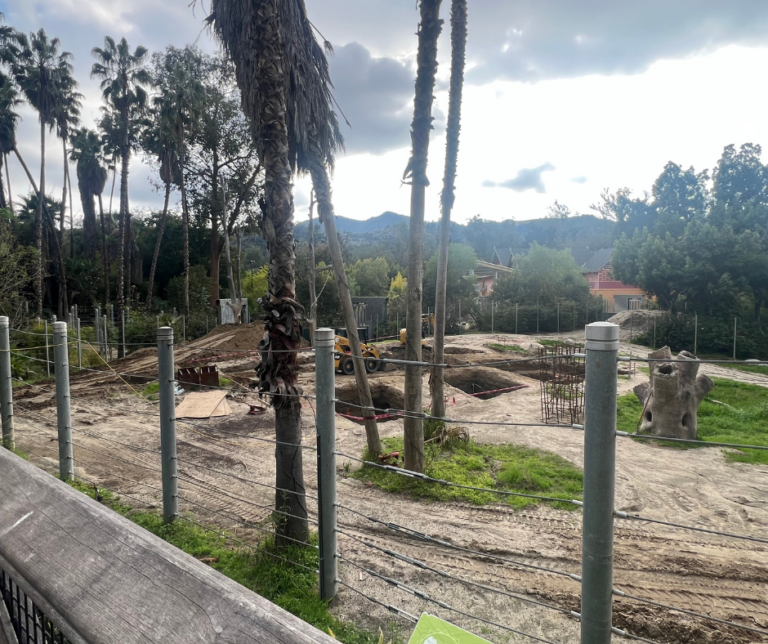
Billy and Tina
Billy is a male Asian elephant who was born in the wild in Malaysia around 1985. Captured and taken from his herd before he was a year old, he was imported to the United States four years later after the Los Angeles Zoo purchased him for $7,000 from the Malaysian Game Department. The zoo claims Billy was brought to the zoo to spare him from being killed by the Malaysian government, which, the zoo said, had been capturing and relocating elephants and in some cases culling the herds because the elephants had been causing damage to palm oil and rubber plantations.
Billy spent his first years at the zoo being trained to submit to commands under threat of a bullhook–a sharp tool used to control elephants through the infliction of pain and fear of the infliction of pain. A 1989 video filmed at the Los Angeles Zoo shows a trainer repeatedly prodding Billy with a bullhook to prompt him to move around the training area. In the video, the trainer talks about putting chains on Billy and describes the training process. “He’s gotten to the point where you can just touch him or you can just basically eliminate the hook and just tell him to back up and he will,” he says. “He knows he has to stay there and [his foot] is not supposed to drop. He knows that if it drops I’ll hit him.”
In 1993, the Los Angeles Zoo sent Billy to Have Trunk Will Travel, presumably for additional training. Have Trunk Will Travel was a Perris, California-based private company that made agreements with zoos to breed elephants and was a member of the Association of Zoos and Aquariums Species Survival Plan. The company also rented out elephants to the entertainment industry and put on traveling shows. The company faced numerous allegations of extreme cruelty to elephants, including beating them with bullhooks, shocking them with stun guns, and chaining their legs for 12 hours a day (after California passed a bullhook ban in 2016, Have Trunk Will Travel moved to Texas and changed its name to The Preserve).
In 1994, Billy was returned to the Los Angeles Zoo where he’s remained ever since.
In 2007, actor Robert Culp and real estate broker Aaron Leider filed a lawsuit, Leider v. Lewis, alleging cruel treatment of the elephants. In a 2012 decision, California Superior Court Judge John L. Segal prohibited the zoo from using bullhooks and electric shock devices to manage the elephants and required the zoo to rototill the soil to make the ground softer and to allow the elephants to exercise a minimum of two hours a day. Judge Segal’s decision made particular mention of Billy:
“The evidence shows that when Billy was much younger, trainers formerly with the Los Angeles Zoo trained him to lie down using a block and tackle. Trainers also used a bull hook, a stick with a nail, or other similar tool. When elephants that were trained or ‘broken’ with a bull hook are subsequently shown a bull hook or an object that looks like a bull hook, they (quite understandably) become afraid, and comply with requests by the trainer or keeper. [The Los Angeles Zoo director] confirmed that if an elephant has been hurt by a bull hook in the past, the elephant will react negatively if a keeper merely shows or displays a bull hook.”
The California Supreme Court reversed Judge Segal’s decision on procedural grounds in 2017.
For most of Billy’s nearly 40 years at the zoo, the Los Angeles Zoo has held Billy separately from the other elephants for reasons the zoo has never made clear. For decades, Billy has been observed engaging in behavior indicative of chronic stress and trauma, including rocking, swaying, and head-bobbing. This behavior is not seen in free-living elephants.
Public records obtained by local activists provide a window into how the Los Angeles Zoo attempted to use Billy for captive elephant breeding to increase the number of elephants held in captivity in zoos. For example, during a three-year period, the zoo tried to collect Billy’s semen at least 55 times. This often involved holding Billy in place using an elephant restraint device and having a zoo employee insert their arm into his anus and massage his prostate to stimulate ejaculation. Despite years of semen collection attempts, Billy has never sired any offspring. The most recent AZA Asian Elephant Population Analysis and Breeding & Transfer Plan recommends that Billy continue to be used for breeding purposes.
Like many elephants held captive in zoos, Billy has suffered from inadequate foot care. For example, records from 2023 show the zoo did not perform foot care on Billy for eight months while he was in musth, resulting in overgrown nails and a significant accumulation of dead tissue. Elephants in the wild naturally maintain their feet through walking on diverse terrains, which helps to wear down their nails and keep their pads clean. Foot disease is a leading cause of death in captive elephants.
Over 800,000 people have signed a petition calling for Billy’s release to a sanctuary. Several Los Angeles City Council members have introduced motions to close the zoo’s elephant exhibit or release Billy to a sanctuary. Most recently, following the zoo’s announcement about the planned transfer, Councilmember Bob Blumenfield introduced a motion to halt the relocation of the elephants until the council has an opportunity to review and vote on all relocation options, specifically accredited sanctuaries. In 2022, the Los Angeles Times’ editorial board called for Billy’s release to a sanctuary: “Billy has put in more than three decades of service at the L.A. Zoo. He has earned retirement in a place where he has more space to roam and a less stressful life.”
Tina
Tina is a female Asian elephant whose country of origin is unknown. She was born in 1966, captured and taken from her herd in 1967, and imported to the United States in 1969. For the next forty years of her life, Tina was used for human entertainment in casinos and circuses across the country.
From 1969 until 1980, Tina was held captive at the Nugget Casino in Nevada. There, she and two other elephants were compelled under threat of a bullhook to perform in a variety of animal acts and serve as a tourist attraction to bring in customers. Photos from this time period show Tina wearing circus costumes, being held in barren enclosures, and wading in a makeshift water hole next to construction debris and trailers.
From 1980 until 2009, Tina was owned by three different circuses. During this time, Tina was held captive with a female elephant named Jewel, who would become her companion for the next 40 years. While held captive by circuses, Tina was transported across the country in tiny trailers and made to perform in shows. In 2009, the USDA confiscated Tina and Jewel because of neglect and mistreatment, including both elephants being dangerously underweight. Tina and Jewel were transferred to the San Diego Zoo, which in turn loaned them to the Los Angeles Zoo beginning in 2010. The Los Angeles Zoo euthanized Jewel in January of 2023 due to “declining health” with no details provided. Less than a year later, Shaunzi, the other female elephant confined in the zoo, collapsed and was euthanized.
Tina is now the sole remaining female elephant in the Los Angeles Zoo. Like Billy, she has frequently been observed engaging in behavior indicative of chronic stress and trauma.
About the Los Angeles Zoo elephant exhibit
The Los Angeles Zoo’s elephant exhibit has been a source of controversy for decades, with a lawsuit alleging cruelty to the elephants, multiple attempts by the City Council to close the exhibit or relocate the elephants to sanctuary, and longstanding grassroots campaigns calling for the exhibit’s closure. The zoo has been featured in the annual “10 Worst Zoos for Elephants in North America” list for several years and in 2023 and in 2024 it was named “The Worst Zoo for Elephants in North America.” Billy and Tina are rotated between four yards which vary in size from a quarter of an acre to a little over one acre, with the entire exhibit and barn providing just three acres of usable space for the elephants held captive there. They are kept separate from one another presumably because the elephants do not get along, which is typical in zoo exhibits where the elephants have little to do, have little space to move away from each other if they want to, and are subject to the chronic stress of captivity and life on display.
In April of 2025, the Los Angeles Zoo announced it would move Billy and Tina to the Tulsa Zoo, resulting in public outcry. Though the Tulsa Zoo’s exhibit (believed to be 10 acres) is slightly bigger than the Los Angeles Zoo’s (four acres) in terms of usable space, it already houses five elephants in a space that’s too small and barren to meet elephants’ needs. With the addition of Billy and Tina, the available outdoor space per elephant would then be reduced to 1.43 acres, which is less than the amount of space per elephant at the LA Zoo. Free-living Asian elephants roam habitats as large as 200,000 acres.
As the NhRP writes in its petition:
“Justice requires setting Billy and Tina free to an accredited elephant sanctuary, where they can exercise their autonomy and extraordinary cognitive complexity to the greatest extent possible—and finally have the opportunity to live fulfilling elephant lives. This is the recommendation of leading experts on elephant cognition and behavior … At an elephant sanctuary, the ‘orders of magnitude of greater space’ compared to zoo captivity ‘permits autonomy and allows elephants to develop more healthy social relationships and to engage in a near natural movement, foraging, and repertoire of behavior … Allowing Billy and Tina to be relocated to another zoo—as the L.A. Zoo plans to do—would merely perpetuate the daily violations of their right to bodily liberty, effectively condemning them to a lifetime of suffering. That inhumane outcome would be manifestly unjust.”
Who's joined us in the fight
Donate to support the fight
Donate online
Mail a check
611 Pennsylvania Ave SE #345
Washington, DC 20003
Planned giving
Create a fundraiser
Highlights from the fight
A timeline of Billy and Tina’s case

05.16.25
The NhRP submitted for filing a common law habeas corpus petition in the Los Angeles Superior Court on behalf of Billy and Tina. The petition seeks recognition of their right to liberty as autonomous beings and their release to an accredited elephant sanctuary. “Though this request may seem extraordinary,” the NhRP writes in our petition, “the Great Writ [of habeas corpus]’s noblest tradition lies in protecting those society previously overlooked—what would be truly extraordinary is for this Court to turn its back on autonomous beings who demonstrably suffer and seek the Court’s protection.”
Elephant cognition and behavior experts Lucy Bates, Richard Byrne, Bob Jacobs, Keith Lindsay, Karen McComb, Cynthia Moss, Mickey Pardo, and Joyce Poole submit declarations in support. Together, their declarations show that elephants are autonomous beings who suffer when deprived of their autonomy in zoos.
The NhRP is also requesting that the court issue a temporary restraining order and a preliminary injunction to prevent the Los Angeles Zoo from moving the elephants to another zoo pending the outcome of the NhRP’s litigation. In April of 2025, the zoo announced it intended to relocate Billy and Tina to the Tulsa Zoo following the deaths of two other elephants in the zoo’s custody in 2023 and 2024.
Habeas corpus is a legal principle that protects against unlawful imprisonment. Common law is used to decide cases that turn on general legal principles—such as liberty and equality—as opposed to those that require interpretation of statutes, constitutions, or treaties. Historically, the common law has been uniquely responsive to evolving standards of morality, scientific discovery, and human experience.
5.16.25
5.20.25
After the court system initially rejected the NhRP’s petition five times on two different days, it is finally accepted in the criminal division of the Los Angeles Superior Court. The case is assigned to Judge William C. Ryan to review.
5.29.25
The NhRP files a motion to submit a supplemental petition, arguing that even though the elephants are no longer in California, the Los Angeles Superior Court retains jurisdiction over the case because Billy and Tina remain in the constructive custody of L.A. Zoo Director Denise Verret and the City of L.A.
